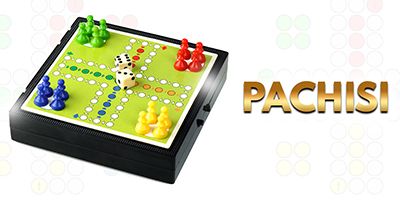Pachisi Game
Pachisi is a board game with a cross and circle design that originated in Ancient India. It is known as "Pasha" in the Mahabharata, an ancient Hindu epic. It is played on a symmetrical cross-shaped board.
Pachisi, commonly known as "Twenty Five," is India's national sport, which has been played for millennia. Pachisi or pasha game should not be confused with the simplified and less skilled modern commercial Western versions of Ludo (UK), Parchs (Spain), Parcheesi (USA), or even Uckers (a naval version of Ludo).
Pachisi Game History
Pachisi game or pasha game is often referred to as India's national sport. The game is thought to have originated in ancient India and is one of the most well-known games from that time period. Also known as Mahabharat Game, the game's name comes from the Hindi word pachis, which means "twenty-five," which is also the highest score that can be achieved with cowrie shells. Twenty-Five is another name for the game.
- Nobody knows exactly when the game was created, but it is thought to have started in India about the 4th century.
- Pachisi reached its pinnacle during the Mogul Empire, from the 16th to the 19th century, when the monarch - Akbar - played games with human pieces on inlaid marble boards, some of which may still be seen.
- Other well-known variations of the game include chausar, chaupar, chaupur, and caupur.
- In the 1860s, it travelled west, first to England (which had taken over control of India from the British East India Company in 1858) and subsequently to Europe.
- The English devised a simpler version called Ludo in the late 1890s, which was primarily designed for and played by youngsters.
- Pachisi made its initial appearance in America between 1867 and 1870, where it was given the name Parcheesi.
- It spread worldwide and various countries have put their own spin on it, like:
- United States: Aggravation, India, Sorry!, Trouble
- France: Jeu de Dada
- Germany: Der Weg zur Herberge
- United Kingdom: Pig-a-Back, Homeward Bound, Patchesi, Ludo
- Middle East and Asia: Nyout, Pat, Twenty-Five
How to Play Pachisi
Since its inception in the 4th century, this ancient pachisi game also known as Mahabharat Game has had plenty of opportunities to develop its gameplay. Following these instructions will help you learn how to play Pachisi:
Step 1): Place a BEAD in the center of the board, a player must roll a grace (a 6, 10, or 25).
Step 2): Depending on how to play pachisi, every time grace is rolled, the player gets a new roll.
Step 3.) Each player takes a turn rolling the die and moving their BEAD down their column the number of spaces given, then counter-clockwise around the entire track before returning up their column.
Step 4): Players must utilize all of their actions on a single BEAD or they will lose their turn.
Step 5): Players have the option of not using their roll in a pachisi board game.
Step 6): Players can land on a square where one of their own BEADs is present.
Step 7): If a player lands on a square occupied by their opponent's BEAD, the opponent's BEAD is removed from the board, and the BEAD must be re-rolled with grace.
Step 8): A player gets another turn if they remove an opponent's BEAD.
Step 9): If a square is designated with an X in the pachisi board game, BEADs cannot be captured.
Step 10): To complete, players must land in the center square with an exact roll.
Pachisi Game Rules
The Pachisi game rules are as follows:
- The pasha game rules say that the game is designed for four players to compete as partners.
- Yellow and Black play against Red and Green, while Yellow and Black sit opposite each other according to pachisi game rules.
- The pieces are first placed in the Charkoni.
- The cowries are thrown by each player in the following order: highest to lowest, then anti-clockwise.
Poker vs Pachisi Board Game
|
Poker |
Pachisi Board Game |
|
Poker is a card game. |
Pachisi is also known as the pasha game is a board game. It is also known as Mahabharat Game. |
|
The poker is played with a deck of 52 cards. |
Pachisi is played with cowrie shells, a board, and dice. |
|
The objective of a poker game is to win the pot. |
To win in pachisi, a player must move their BEADs around the board and proceed up their home column back onto the center square. |
Play Poker Games & Win Real Cash Daily
Pachisi board game is one of the most enjoyable games online but you can’t make money with it. However, you can play poker games online and win real cash daily. All you have to do is pick the poker game you want to play online poker, and you can start making real cash online.
Why choose Poker over Mahabharat Game also known as pachisi board game:
- There are more Poker websites than Pachisi websites.
- You can win real cash daily on Poker websites,
- You can play with your friends for free and still enjoy a very competitive game.
- Poker is played worldwide and enjoyed by everyone,
Mahabharata Game FAQs
1.) Is Pachisi same as Ludo?
Pachisi was a Mahabharat Game and has been around since the 4th Century. Ludo came around much later. It can be said that Ludo is a variation or a distant cousin of pachisi game, but they are not the same.
2.) What is the difference between Parcheesi and Pachisi?
There is no difference between the two. Pachisi is the original pasha game and parcheesi is the trademarked name by American game makers, Selchow and Righter.
3.) Is Pachisi like Sorry?
Players in both Parcheesi and Sorry! move pawns around the board. Players in Parcheesi roll dice to determine movement, but a Sorry! player's fate is determined by a drawn card.
4.) Why is Ludo called Pachisi?
Ludo and Parcheesi are westernized versions of the original game. The name of the game comes from the Hindi word paccs, which means "twenty-five," the highest score that can be achieved with cowrie shells; consequently, the pasha game is also known as Twenty-Five.


